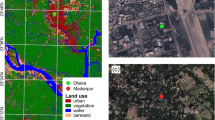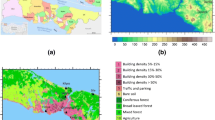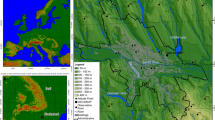Summary
The paper presents a study of the Urban Heat Island Circulation (UHIC) in Göteborg, Sweden. Observations and recordings have been carried out from 1981 to 1986 during winter nights with anticyclonic weather conditions. The UHIC develops in general at a large negative net radiation balance, when the heat island intensity is at least 2.5°C, the wind speed less than 3 m/s and the sky is clear. If the weather conditions are favourable the UHIC starts 4–6 hours after midnight and stops a few hours after sunrise. An increase in cloud cover during the late night will not prevent the development of the UHIC. The UHIC layer extends to 40–70 metres in the vertical direction and to 10–13 km in the horizontal direction. The UHIC layer is capped by an inversion and the flow is almost independent of the direction of the regional flow. The UHIC is of great importance for the concentrations of air pollutions in Göteborg, as it transports both polluted and clean air. The study is a part of a clean air programme in the Göteborg area.
Similar content being viewed by others
References
Barlag, A. B., 1989: The significance of country breezes for urban planning. Paper presented at the IFHP/CIB/WMO/IGU International Conference on Urban Climate, Planning and Building in Kyoto, Japan, November 6–11, 1989.
Beckröge, W., 1988: Aspekte für die Planung. In: Löbel, J., Schirmer, H. (Hrsg.)Stadtklima und Luftreinhaltung. Berlin Heidelberg New York Tokyo: Springer, 428 S.
Berg, H., 1943: Der Einfluß einer Großstadt auf Bewölkung, Niederschlag und Wind.Biokl. Beibl. Met. Zeitschr. 10, 65–70.
Bornstein, R. D., Johnson, D. S., 1977: Urban-rural wind velocity differences.Atmos. Env. 11, 597–604.
Draxler, R. R., 1986: Simulated and observed influence of the nocturnal urban heat island on the local wind field.J. Climate Appl. Meteor. 25, 1125–1133.
Dreiseitl, E., Reiter, E. R., 1978: Local winds inside and outside a city.Arch. Met. Geoph. Biokl., Ser. B. 26, 305–317.
Geiger, R., 1966:The Climate Near the Ground. New York: Harvard University Press, 611 pp.
Gold, E., 1956: Smog. The rate of influx of surrounding cleaner air.Weather,11, 230–232.
Goldreich, Y., Surridge, A. D., 1988: A case study of low level country breeze and inversion heights in the Johannesburg area.J. Clim. 8, 55–66.
Holmer, B., 1980: Omlandsbris-Stadens Termiska Vindsystem.Geografiska Notiser. 38, 104–107.
Holmer, B., in preparation: Local airflow during NO x /NO2 pollution episodes in Göteborg, Sweden.
Kratzer, P. A., 1956:Das Stadtklima. Braunschweig: Vieweg, 144 pp.
Lauscher, F., Steinhauser, F., 1932: Strahlungsuntersuchungen in Wien und Umgebung (Beiträge zur Kenntnis des Stadtklimas 2).Wr. Akad. Wiss., Math.-naturwiss. Kl. 141, 15–23.
Lee, D. O., 1979: The influence of atmospheric stability and the urban heat island on urban-rural wind speed differences.Atmos. Env. 13, 1175–1180.
Liljeqvist, G. H., 1979:Meteorologi: Strålning. Uppsala: Meteorologiska institutionen, Uppsala universitet, 197 pp.
Oke, T. R., 1978:Boundary layer climates. London New York: Methuen, 372 pp.
Okita, T., 1965: Some chemical and meteorological measurements of air pollution in Asahikawa.Int. J. Air Wat. Pollut. 9, 323–332.
Park, H.-S., 1986: Features of the heat island in Seoul and its surrounding cities.Atmos. Env. 20, 1859–1866.
Pooler, F., Jr., 1963: Airflow over a city in terrain of moderate relief.J. Appl. Meteor. 2, 446–456.
Schmauss, A., 1921: Die Windbeobachtung in Großstädten.Meteor. Zeitschr. 38, 226.
Schreffler, J. H., 1978: Detection of centripetal heat-island circulations from tower data in St. Louis.Bound. Lay. Climate 15, 229–242.
Schreffler, J. H., 1979: Heat island convergence in St. Louis during calm periods.J. Appl. Meteor. 18, 1512–1520.
Taesler, R., 1980: Studies of the development and thermal structure of the urban boundary layer in Uppsala. Part 2, data analysis and results. Reports 61, Department of Meteorology, Uppsala, Sweden, 177 pp.
Vukovich, F. M., King, W. J., Dunn, J. W., Worth, J. J. B., 1979: Observations and simulations of the diurnal variation of the urban heat island circulation and associated variations of the ozone distribution. A case study.J. Appl. Meteor. 18, 836–854.
Wong, K. K., Dirks, R. A., 1978: Mesoscale perturbations on airflow in the urban mixing layer.J. Appl. Meteor. 17, 677–688.
Author information
Authors and Affiliations
Additional information
With 7 Figures
Rights and permissions
About this article
Cite this article
Eliasson, I., Holmer, B. Urban Heat Island Circulation in Göteborg, Sweden. Theor Appl Climatol 42, 187–196 (1990). https://doi.org/10.1007/BF00866874
Received:
Issue Date:
DOI: https://doi.org/10.1007/BF00866874




